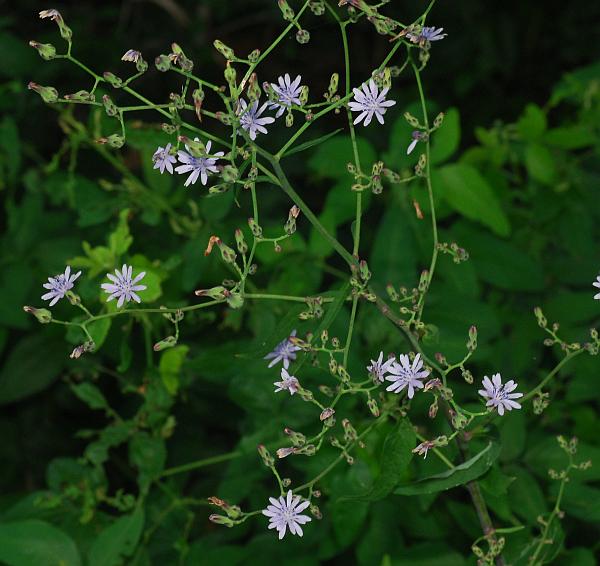Lactuca floridana (L.) Gaertn.
Florida Lettuce

Native
CC = 3
CW = 3
MOC = 69
© SRTurner
Lactuca floridana (L.) Gaertn.Florida Lettuce | |
 |
Native CC = 3 CW = 3 MOC = 69 |
© SRTurner |
|
Family - Asteraceae/Cichorieae Habit - Annual or biennial forb with white sap. Stems - Erect, to 3 m or more, hollow between the nodes, single from the base, well-branched in the inflorescence, glabrous, often purple-spotted. Sap pure white with no yellow or tan coloration.
Leaves - Alternate, simple, well developed along stems, highly variable. Basal and lower stem leaves mostly 7-35 cm long, usually with a winged petiole, narrowly ovate, ovate, or obovate in outline, variously toothed and/or deeply pinnately lobed, the margins sometimes minutely hairy, sometimes with a pair of narrowly triangular basal lobes clasping the stem, the undersurface sometimes short-hairy, especially along the midvein; the middle and upper stem leaves mostly lanceolate to ovate or obovate, pinnately lobed to nearly entire, the margins usually glabrous, sometimes with a pair of narrowly to broadly triangular basal lobes clasping the stem, the undersurface glabrous.
Inflorescences - Terminal, well-branched panicles of 50-100 or more flower heads.
Heads - Ligulate. Involucre usually urn-shaped, 8-9 mm long at flowering, elongating to 10-14 mm at fruiting, the bracts 14-17, imbricate, green with purple apices. Florets 10-17.
Florets - Corollas lavender to purplish blue or blue, sometimes very pale. Ligules to 6mm long, the apex toothed. Pappus 5-7 mm long.
Fruits - Achenes 4-6 mm long, 1.5-2.0 mm wide, brown to dark brown, often mottled, flattened, with somewhat thickened margins and 4 or 5 nerves or ridges on each face, narrowed or tapered abruptly, beakless or with a short, stout beak much less than 1/2 as long as the body. Pappus persistent, to 8 mm long, of white capillary bristles.
Flowering - July - October. Habitat - Streambanks, forests, savannas, sand savannas, glades, bases of bluffs, pond margins, railroads, roadsides, open, disturbed areas. Origin - Native to the U.S. Lookalikes - Broadly, L. tatarica, though this species is rare in Missouri. Vegetatively similar to L. canadensis. Other info. - This common species of lettuce is found across most of Missouri. Its range includes most of the eastern half of the U.S. and also extends into Canada. The plant is easily recognized when in flower, by its well-branched inflorescences of blue flowering heads. Although the inflorescence can have over 100 flower heads at once, these typically open just a few at a time. The leaves of the plant are highly variable and can be deeply lobed, unlobed, or anything in between. The color of the sap is pure white with no trace of yellow or tan. This differentiates the species from the closely related L. canadensis, which can appear similar vegetatively, but which has sap of a tan or yellowish color. Under favorable conditions L. floridana can top 14 feet in height. Photographs taken at the Kansas City Zoo, 10-25-99, and in Brown Summit, NC., 9-21-02 (DETenaglia); also near Labadie, Franklin County, MO, 9-5-2009, along the Katy Trail near Dutzow, Warren County, MO, 8-10-2014 and 8-6-2015, along the Katy Trail near Marthasville, Warren County, MO, 9-5-2019 and 9-19-2024, and at Glassberg Conservation Area, Jefferson County, MO, 8-5-2020 (SRTurner). |